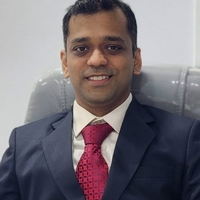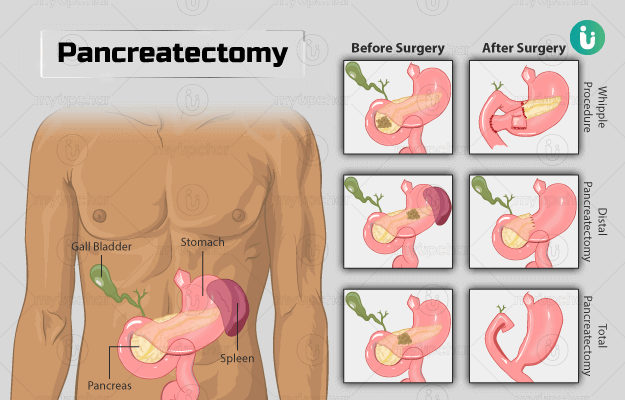Summary
Pancreatectomy is a surgery to remove all or some portion of the pancreas, the abdominal organ responsible for producing insulin. This surgery is performed to treat pancreatic conditions, including pancreatic cancer. The various methods by which pancreatectomy is performed include Whipple procedure and distal and total pancreatectomy.
In this surgery, along with the pancreas, your spleen, gallbladder, and part of the stomach and small intestine may also be removed.
Before the surgery, medical tests are performed to check your overall health otherwise. You will need to fast for the surgery. Your doctor may ask you to quit smoking or stop alcohol before the surgery. The surgery is done under general anaesthesia. After the surgery, care should be taken to avoid strenuous activities. You may need to follow a high protein and carbohydrate diet. Avoid fat-rich food after surgery. A follow-up one to two weeks after the surgery is expected.
- What is pancreatectomy?
- Why is pancreatectomy recommended?
- Who can and cannot get pancreatectomy?
- What preparations are needed before pancreatectomy?
- How is pancreatectomy done?
- How to care for yourself after pancreatectomy?
- What are the possible complications/risks of pancreatectomy?
- When to follow up with your doctor after a pancreatectomy?
What is pancreatectomy?
Pancreatectomy is a surgical procedure to remove part or whole of the pancreas. The pancreas is an organ located near to the intestine, stomach, and other organs. It consists of three parts: a wider head, middle, and tail. The pancreas plays the following crucial functions in our body:
- It produces various juices called enzymes that aid in the digestion of food.
- It produces hormones like glucagon and insulin. These hormones maintain an optimum blood glucose level in the body and help the body to consume and store energy from food.
Pancreatectomy is performed to treat various pancreatic conditions such as pancreatic cancer.
It can be done by:
Whipple procedure - in which the pancreatic head is removed. The doctor may also remove the gallbladder, duodenum, and some part of the bile duct and stomach.
Distal pancreatectomy - the middle and tail portions of the pancreas are removed. The spleen is also removed.
Total pancreatectomy - removal of the entire pancreas. The gall bladder, spleen, stomach, bile duct, duodenum, and lymph nodes are also removed.
Why is pancreatectomy recommended?
Pancreatectomy is recommended for the following conditions and their symptoms:
Cancer: This includes various types of cancer involving the pancreas, such as:
- Acinar cell tumour
- Ampullary cancer
- Adenocarcinoma
- Cancer of the distal (lower) part of the bile duct
- Duodenal cancer
- Islet cell tumour
- Lymphoma
- Cystadenocarcinoma
- Neoplasms
- Papillary cystic neoplasms
- Cystadenoma
Symptoms of pancreatic cancer include:
- Diarrhoea
- Jaundice (yellowing of the eyes and skin) without pain
- Weight loss
- Dark urine and grey stools
- New-onset of diabetes
Pancreatitis: Inflammation of the pancreas, i.e., pancreatitis, can lead to:
- Necrotising pancreatitis (an infection that results in the death of pancreatic tissue)
- Severe chronic pancreatitis
Symptoms of pancreatitis are:
- Diarrhoea
- Abdominal pain
- Weight loss
- Difficulty eating
- Rarely, new-onset diabetes
Pancreatectomy can also be recommended in conditions such as severe hyperinsulinemic hypoglycemia (a condition with unregulated secretion of insulin, the hormone that regulates blood sugar levels, even in the presence of low blood sugar level) and severe trauma.
What preparations are needed before pancreatectomy?
Before the surgery, the following preparation is needed:
Medical tests: You may be asked to get these tests before the surgery:
- Ultrasound
- Computed tomography (CT) scan
- Blood tests (electrolytes, complete blood count, kidney function test and liver tests)
- Endoscopic retrograde cholangiopancreatography (ERCP) to examine the biliary ducts and pancreas
- Chest X-ray
- Electrocardiogram
Lifestyle and health:
- Avoid alcohol completely before the surgery.
- If you smoke, try to quit smoking as it can delay your healing after the surgery.
- Inform your healthcare practitioner if you recently had any illness, including cold, flu, fever or herpes (sores occurring on the genitals or around the mouth).
- You may be asked not to drink or eat anything for several hours before the surgery.
Medications:
- Stop taking blood-thinning medicines like aspirin, ibuprofen, or warfarin.
- Your doctor will tell you which medicine you can take until the day of the surgery.
- You can take the advised medicines with a small quantity of water on the day of the surgery.
The doctor will let you know the benefits and risks associated with the surgery. You may need to sign a consent form before the surgery.
How is pancreatectomy done?
For the surgery:
- A doctor will place a urinary catheter in your urinary bladder to drain urine.
- A nasogastric tube (a tube through your nose into the stomach) will also be put in to help you breath.
- A healthcare practitioner will give you general anaesthesia to ease your pain during the surgery.
- The surgeon will perform this surgery through a cut on your abdomen.
The type of surgery to be performed depends on the kind of the tumour (cancerous or non-cancerous) present. Pancreatectomy is performed in one of the following manner:
- Whipple procedure: It is the most common procedure performed to treat cancer of the pancreas. In this procedure, the pancreatic head is removed together with the first part of the small intestine (duodenum), gallbladder (the organ that stores bile, a fluid that helps in digestion of fats) and a part of the duct that carries bile. The remaining parts of the pancreas, stomach, and bile duct are connected to the small intestine left in place. This modification helps in releasing enzymes and hormones, made by the pancreas and bile into the body.
- Distal pancreatectomy: In this method, the tail and the body of the pancreas are removed. Along with these parts, your left diaphragm (a muscle that separates the abdomen from the chest cavity), spleen (a soft and purple, small-sized organ behind your stomach and under the diaphragm), intestine, and left kidney and adrenal gland (a small triangular-shaped organ on top of your kidneys) may also be removed.
- Total pancreatectomy: This procedure is performed to remove the entire pancreas. The surgeon will also remove spleen, gallbladder, part of the small intestine, bile duct, part of the stomach, and lymph nodes (part of the immune system) surrounding your pancreas.
Depending on the method of the surgery, the time required for completion may vary. For example, the Whipple procedure takes around four to seven hours.
After the surgery:
- You will be shifted to the recovery ward and then a hospital ward. You may have to stay in the hospital for seven to 10 days.
- In the recovery area, a nurse will monitor your progress.
- When you wake up, the catheter and nasogastric tube would still be in place. You will also have a drainage tube in your abdomen to remove any fluid accumulated. These tubes will be removed after three to five days.
- You will be given painkillers to relieve the pain after the surgery.
- You will not be able to eat full meals for a few days. The fluid and medicines will be supplied through an intravenous (through the vein) line. After two days, you can eat soft food.
- You will be encouraged to move around as early as possible.
How to care for yourself after pancreatectomy?
You may have a drain at the incision site once you are discharged. A nurse will give you information about taking care of the drain. The following care should be taken at home:
Wound care:
- Your healthcare practitioner will advise you on taking care of the surgical wound.
- If staples, stitches, or glue was used to close the incision, you may remove the dressing and take a shower.
- If staples are used to close the incision, the doctor may remove them in about a week after the surgery.
- If tape strips are used, then use a plastic wrap to cover your cut before showering for the first few days after surgery.
- Avoid bathing in a bathtub or swimming until your doctor allows you to do so.
Activity:
- You will be able to resume most of your activities within six to eight weeks.
- You can take short walks and use the staircase. However, avoid strenuous activities like heavy exercises, weight lifting, or any activity that makes it difficult to breathe.
- Do not lift more than 4.5 to 7 kilograms of weight.
Diet:
- You may have difficulty in digesting fat after the surgery.
- Your doctor may ask you to eat foods rich in protein and carbohydrates and low in fat.
- Eat frequent, small meals instead of large meals.
- You may need pancreatic enzymes and insulin after the surgery, which can be prescribed by the doctor.
Medicine:
- Take your medicines for pain as prescribed by the doctor.
- Avoid taking aspirin, naproxen or ibuprofen as these medicines may increase bleeding from the wound site.
You will be able to start driving six weeks after surgery and can resume work in three to four months, depending on your recovery and the kind of work you do.
The benefits of the surgery include:
- Increased survival time
- Cures the problem by removing the cancerous growth
When to see the doctor?
Inform your doctor if you have the following symptoms after the surgery:
- Fever of 38.3°C or higher
- Problem with the drain
- Grey-coloured stools
- Yellow colouration of skin and eyes
- Unable to drink or eat
- Uncontrollable nausea, diarrhoea or constipation
- Difficulty in breathing
- Pain even after taking painkillers
- Coloured discharge from the wound
- Redness, bleeding or warmness at the wound site
What are the possible complications/risks of pancreatectomy?
The following are the combined risks for general anaesthesia and surgery:
- Infection
- Heart problems
- Allergic reaction to medicine
- Blood clots in the legs or lungs
- Bleeding
- Breathing problems
The risks associated with this surgery are:
- Weight loss
- Diabetes, if the body is not able to make enough insulin
- Problems with stomach emptying
- Leakage of fluid from the pancreas, stomach, bile duct, and intestine
When to follow up with your doctor after a pancreatectomy?
You may need a follow-up visit one to two weeks after the surgery.
Disclaimer: The above information is provided purely from an educational point of view and is in no way a substitute for medical advice by a qualified doctor.
Find Gastroenterologist in cities
- Gastroenterologist in Gurgaon
- Gastroenterologist in Bangalore
- Gastroenterologist in Chennai
- Gastroenterologist in Jaipur
- Gastroenterologist in Ahmedabad
- Gastroenterologist in Noida
- Gastroenterologist in Mysore
- Gastroenterologist in Visakhapatnam
- Gastroenterologist in Hyderabad
- Gastroenterologist in Pune
Surgery Cost In Your City
Doctors for Pancreatectomy

Dr. Paramjeet Singh.
Gastroenterology
10 Years of Experience

Dr. Nikhil Bhangale
Gastroenterology
10 Years of Experience

Dr Jagdish Singh
Gastroenterology
12 Years of Experience

Dr. Deepak Sharma
Gastroenterology
12 Years of Experience
References
- UCSF Department of Surgery [internet]. University of California San Francisco. California. U.S.A.; Pancreatectomy
- Pucci MJ, Kennedy EP, Yeo CJ. Pancreatic cancer: clinical aspects, assessment, and management. In: Jarnagin WR, ed. Blumgart's Surgery of the Liver, Biliary Tract, and Pancreas. 6th ed. Philadelphia, PA: Elsevier; 2017:chap 62.
- Shires GT, Wilfong LS. Pancreatic cancer, cystic pancreatic neoplasms, and other nonendocrine pancreatic tumors. In: Feldman M, Friedman LS, Brandt LJ, eds. Sleisenger and Fordtran's Gastrointestinal and Liver Disease: Pathophysiology/Diagnosis/Management. 10th ed. Philadelphia, PA: Elsevier Saunders; 2016:chap 60.
- Jesus-Acosta AD, Narang A, Mauro L, Herman J, Jaffee EM, Laheru DA. Carcinoma of the pancreas. In: Niederhuber JE, Armitage JO, Kastan MB, Doroshow JH, Tepper JE, eds. Abeloff's Clinical Oncology. 6th ed. Philadelphia, PA: Elsevier; 2020:chap 78.
- National Health Service [internet]. UK; Pancreatic Cancer
- Fogel EL, Sherman S. Diseases of the gallbladder and bile ducts. In: Goldman L, Schafer AI, eds. Goldman-Cecil Medicine. 25th ed. Philadelphia, PA: Elsevier Saunders; 2016:chap 155.
- Jackson PG, Evans SRT. Biliary system. In: Townsend CM Jr, Beauchamp RD, Evers BM, Mattox KL, eds. Sabiston Textbook of Surgery. 20th ed. Philadelphia, PA: Elsevier; 2017:chap 54.
- UPMC Children's Hospital of Pittsburgh [Internet]. Pennsylvania. US; What Does the Spleen Do?
- Johns Hopkins Medicine [Internet]. The Johns Hopkins University, The Johns Hopkins Hospital, and Johns Hopkins Health System; Adrenal Glands
- Nessa Azizun, Rahman Sofia A., and Hussain Khalid. Hyperinsulinemic Hypoglycemia – The Molecular Mechanisms. Front Endocrinol (Lausanne). 2016; 7: 29. PMID: 27065949.
- Diabetes.co.uk [Internet]. Coventry. UK; Insulin
- Gumbs AA, Rodriguez Rivera AM, Milone L, Hoffman JP. Laparoscopic pancreatoduodenectomy: a review of 285 published cases. Ann Surg Oncol. 2011 May. 18 (5):1335-41. PMID: 21207166.
- Limongelli P, Belli A, Russo G, Cioffi L, D'Agostino A, Fantini C, et al. Laparoscopic and open surgical treatment of left-sided pancreatic lesions: clinical outcomes and cost-effectiveness analysis. Surg Endosc. 2012 Jul. 26 (7):1830-6.
- Butturini G, Partelli S, Crippa S, Malleo G, Rossini R, Casetti L, et al. Perioperative and long-term results after left pancreatectomy: a single-institution, non-randomized, comparative study between open and laparoscopic approach. Surg Endosc. 2011 Sep. 25 (9):2871-8. PMID: 21424200.
- Zureikat AH, Nguyen KT, Bartlett DL, Zeh HJ, Moser AJ. Robotic-assisted major pancreatic resection and reconstruction. Arch Surg. 2011 Mar. 146 (3):256-61. PMID: 21079111.
- Oxford University Hospitals [internet]: NHS Foundation Trust. National Health Service. U.K.; About pancreatic surgery
- University Hospitals Plymouth NHS Trust [Internet]. National Health Service. UK; Surgical treatment of the pancreas












